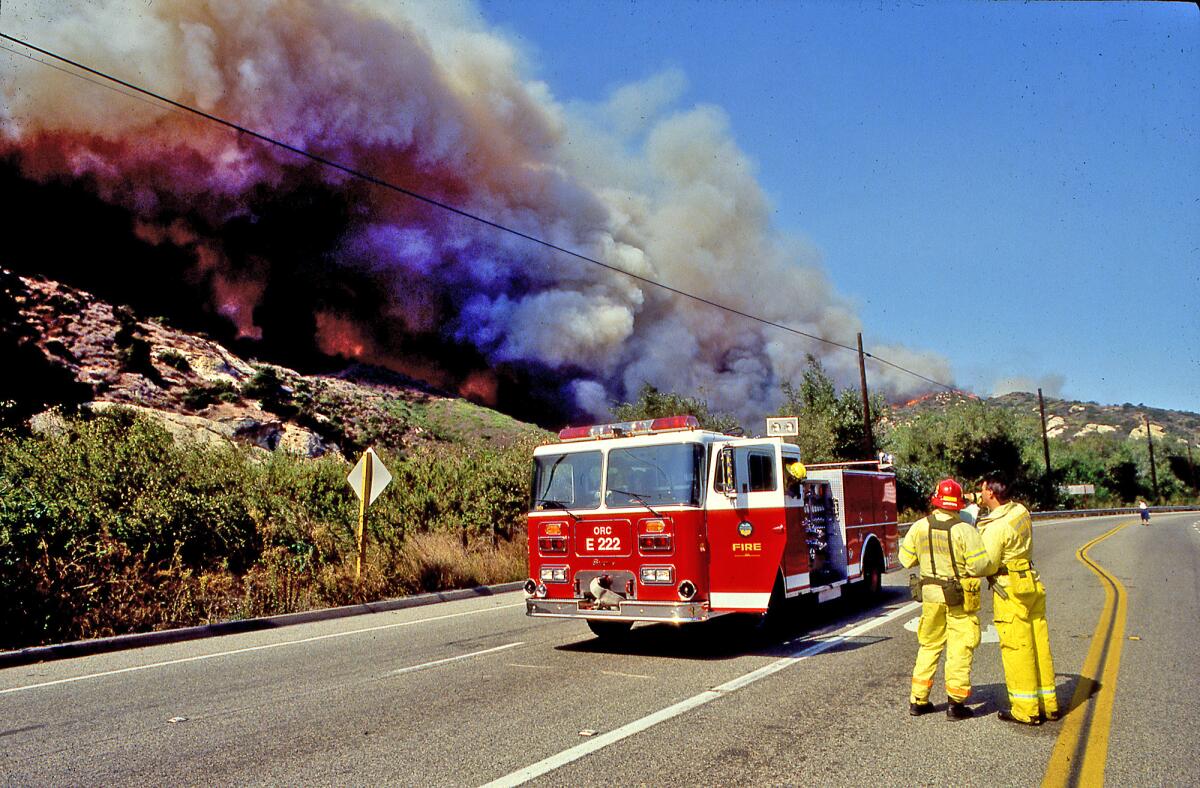After reports of dry hydrants amid Palisades fire, Laguna Beach officials highlight resilience of local water infrastructure

- Share via
Local officials highlighted ongoing efforts to ensure Laguna Beach has enough water getting to hydrants so firefighters can do their jobs during a news conference Monday, after returning from a visit to fire-ravaged Pacific Palisades.
Mayor Alex Rounaghi and City Manager Dave Kiff checked in with firefighters stationed in the Huntington Palisades neighborhood over the weekend before hosting a Zoom session with reporters. They were joined by Laguna Beach Fire Chief Niko King and Laguna Beach County Water District General Manager Keith Van Der Maaten.
“I was just struck by how much it looks like Laguna Beach,” Kiff said of the community on the edge of the Palisades fire’s reach. “Parts of it, especially areas where we drove through, you could picture it being Skyline [Drive in Laguna Beach]. I mean, just the structure of the road, how narrow it is, how much vegetation is around.”
Laguna officials addressed a variety of concerns raised in the wake of multiple fires that consumed large swaths of Los Angeles County. Among these were reports that fire hydrants went dry as crews battled flames.
Los Angeles’ fire hydrants are supplied by three water tanks that each hold about one million gallons. Amid the fires, local water infrastructure faced four times its normal demand for 15 hours straight.
As water ran low, it became difficult to maintain enough pressure in lines to pump against gravity into communities in the canyons. Former Los Angeles Department of Water General Manager Martin Adams told the Los Angeles Times the system was made to douse individual house fires, not meant to handle kind of massive blazes that have become increasingly common in California.
By comparison, Laguna Beach’s current water infrastructure was designed with lessons of the 1993 Laguna Canyon Fire in mind, Van Der Maaten said. He noted that during that disaster, which scorched 16,684 acres and destroyed 366 homes, six of the reservoirs supplying the city at the time ran out of water.

Since then, the Laguna Beach County Water District has added two reservoirs, bringing its total number up to 21 with a combined storage capacity of 33.5 million gallons. In addition, numerous pumps with generators to power them have been incorporated into the system to ensure water gets to where it needs to be in an emergency. Two heli-hydrants, facilities set up in remote areas so water-dropping aircraft can resupply faster, have also been created near Laguna Canyon, Van Der Maaten said.
He and Rounaghi also highlighted progress on the Doheny desalination plant and plans to drill a new well in partnership with Newport Beach and Fountain Valley, further improving Laguna Beach’s water resiliency moving forward.
Van Der Maaten said “right now we have ample supply,” and “we can rely on our pumps, our generators, to function they way they’re supposed to.”
However he noted that no municipality’s water supply is limitless and “every water system at some point will run out of water.” Meanwhile in the face of climate change, devastating fires capable of pushing infrastructure to its limits are becoming part of what Rounaghi called a “new normal.”
“We plan based on modeling,” Van Der Maaten said. “We have modeling that shows our system’s in good shape. It’s based on certain criteria. But I think the question coming out of this is do we need to increase that planning to more extreme situations?”
Meanwhile, emergency response teams in Orange County are are closely monitoring conditions and responding immediately with as many resources as can be spared even on small hot spots. On Saturday, county and city firefighters stamped roughly 20 square feet of smoldering vegetation on the 31100 block of Coast Highway and responded to a patch of hot coals that may have been used as a warming fire near Soka University in Aliso Viejo. Crews stayed behind to make sure there were no lingering embers.
All the latest on Orange County from Orange County.
Get our free TimesOC newsletter.
You may occasionally receive promotional content from the Daily Pilot.




